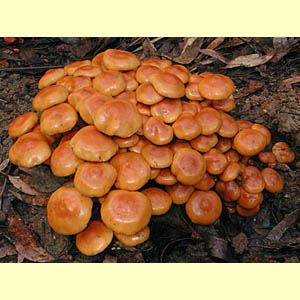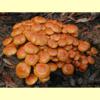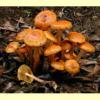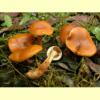
images/Pholiota_malicola/Pholiota_malicola_KRT2825.jpg



_AL_20_sml.jpg)
Diagnostic characters
Medium to large agaric, growing on the ground, in litter or mulch or on wood, with a rusty to ochre-brown, clay-brown or dark brown spore print. Pileus yellow, orange or brown, viscid (when fresh). Lamellae adnexed, adnate or sinuate or notched. Stipe central. Partial veil remnants a ring zone or a membranous annulus. Spores yellow-brown or brown, smooth; germ pore narrow or broad. Cheilocystidia present. Chrysocystidia absent. Lamellar trama regular. Pileipellis a cutis. Clamp connections present.
Similar genera
The mature pileus is smooth, honey-brown and somewhat hygrophanous, and resembles that of Psilocybe subaeruginosa; but this has a purple-brown spore print and does not grow in caespitose clusters. The pileus is also similar to that of some of the larger species of Galerina, such as G. patagonica, but these have warty spores with a plage. Some larger species of Gymnopilus grow in dense clusters, but the pileus is dry and the spores are warty. Fruit-bodies of Pholiota malicola can be quite large, with the pileus reaching 150 mm in diameter and the stipe as long as 230 mm. Other species of Pholiota are often smaller, not always hygrophanous or growing in caespitose clusters, and often have chrysocystidia.
Australian species
One species: Pholiota malicola. This is keyed out separately because it is larger than most other Pholiota species and grows in dense clusters.
Citation of species
Pholiota malicola (Kauffman) A.H.Sm., Ann. Mycol. 32: 480 (1934).
Australian distribution
W.A., Vic. and Tas. (and probably also south-eastern N.S.W.).
Habitat
In native forests, mostly wet forest. Usually on or at the edge of tracks.
Substrate
On wood or litter, most often on the ground, presumably attached to buried wood.
Trophic status
Saprotrophic.
References
Fuhrer, B. (2005), A Field Guide to Australian Fungi. Bloomings Books, Hawthorn. [Description and Illustration of P. malicola]
Fuhrer, B. & Robinson, R. (1992), Rainforest Fungi of Tasmania and South-east Australia. CSIRO Press, East Melbourne. [Illustration of P. malicola]
Hongo, T. & Mills, A.K. (1988), Five noteworthy larger fungi new to Tasmania, Australia, Trans. Mycol. Soc. Japan 29: 351–357. [Microcharacters of P. malicola]
McCann, I.R. (2003), Australian Fungi Illustrated. Macdown Productions, Vermont. [Illustration of Pholiota sp., p. 38, is most likely P. malicola]
Smith, A.H. & Hesler, L.R. (1968), The North American species of Pholiota. Hafner Publishing Company, New York. [Description, B&W Illustration and Microcharacters of P. malicola ]
